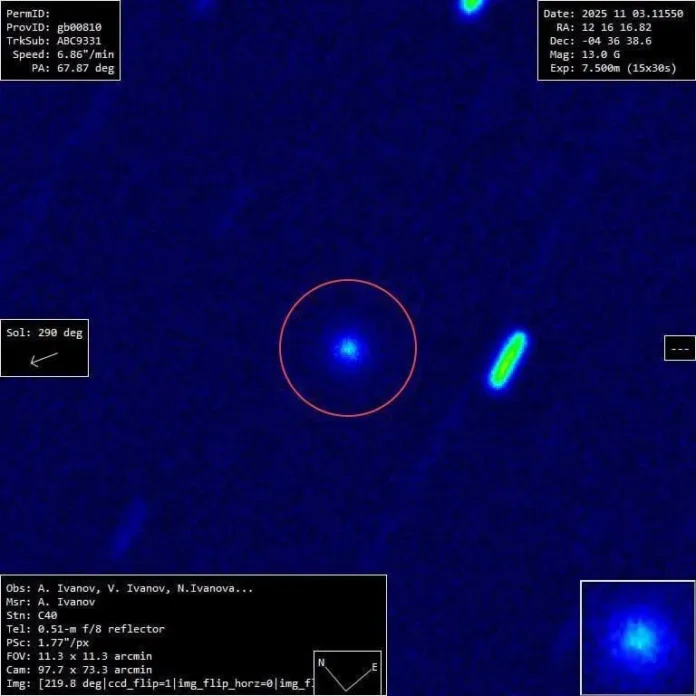
Key Developments
- Astronomer Gennady Borisov discovered a second mysterious object, C/2025 V1, on November 2, 2025, just days after interstellar object 3I/ATLAS passed closest to the Sun, raising questions about whether the two objects could be connected
- The new object’s orbit is tilted 113 degrees and travels nearly perpendicular to 3I/ATLAS, with both objects showing no visible comet tails despite being close enough to the Sun that natural comets would typically display bright streaming gas
- Scientists will use the Webb Space Telescope to analyze 3I/ATLAS when it reaches its closest approach to Earth on December 19, 2025, measuring jet speeds and composition to determine if the object is a natural comet or something technological
By Samuel Lopez
CALIFORNIA (USA Herald) – The cosmos just delivered another puzzle. Less than 48 hours after the interstellar object 3I/ATLAS made its closest approach to the Sun, Gennady Borisov spotted something new in the inner solar system.
Borisov, the same astronomer who discovered the interstellar comet 2I/Borisov back in 2019, found the object now designated C/2025 V1 on the morning of November 2, 2025. What makes the timing remarkable is not just the discovery itself, but that both objects appeared in the same telescope frame, creating an unprecedented cosmic coincidence.
Harvard astronomer Avi Loeb, who has been tracking 3I/ATLAS closely, explained in a recent Newsmax interview that C/2025 V1 occupies an unusual category scientists call “nearly interstellar.” The object’s orbit has an eccentricity of 1.0095, which sits just barely above the threshold of 1.0 that would make it unbound from the Sun’s gravity.
Think of eccentricity as a measure of how stretched an orbit is. A perfect circle has an eccentricity of zero, while anything above 1.0 means the object is moving fast enough to escape the solar system entirely. But the measurement uncertainty of 0.0026 means C/2025 V1 could actually be bound to the Sun after all.
The most likely explanation places C/2025 V1 as a visitor from the Oort cloud, that vast shell of icy objects surrounding our solar system at distances up to 100,000 times farther than Earth orbits the Sun. When scientists run the orbital math backward to where planets cannot influence the trajectory, the eccentricity likely drops below 1.0, suggesting the object has been part of our solar system all along.
A small gravitational nudge from Jupiter during its close pass by the Sun could easily make a bound Oort cloud object appear slightly unbound in the calculations. Even unmeasured outgassing, the process where ice turns to vapor as an object heats up, can shift the apparent orbital numbers.
What catches attention is the geometry. C/2025 V1 travels on an orbital plane inclined 113 degrees relative to the ecliptic, the flat disk where most planets orbit. Its path runs nearly perpendicular to 3I/ATLAS, like two highways crossing at right angles in three-dimensional space.
Without additional propulsion beyond gravity, the two objects never came closer than 225 million kilometers to each other, with their orbital paths separated by at least 75 million kilometers at the nearest point. The measured non-gravitational acceleration of 3I/ATLAS, the small push it gets from outgassing, is not strong enough to bridge that gap.
But the question on Loeb’s mind goes deeper than orbital mechanics. One of the fundamental unknowns surrounding 3I/ATLAS is whether it represents something natural or technological. Recent images show the object sporting at least seven distinct jets shooting material into space.
Those jets point in opposite directions, which creates a physics problem. For a natural comet to produce the measured acceleration while firing jets in multiple directions, it would need to eject somewhere between 10 and 20 percent of its total mass, possibly more. That would mean a substantial cloud of debris now surrounds what remains of 3I/ATLAS, material that should be easy to detect and analyze.
The composition of that debris holds the answer. Natural comets sublime water ice, carbon dioxide, and other volatiles when heated by the Sun, ejecting material at speeds around 0.3 to 0.5 kilometers per second. Chemical rockets, by contrast, expel exhaust at 3 to 5 kilometers per second, ten times faster.
Ion thrusters reach even higher speeds, between 10 and 50 kilometers per second. A technological thruster could deliver the same momentum change while ejecting far less mass, leaving behind a much smaller debris signature.
The test is straightforward. Scientists need to measure three things during the coming month as 3I/ATLAS approaches Earth: the speed of the outflowing gas, how much mass is flowing out, and what chemical elements make up the jets.
The Webb Space Telescope can perform spectroscopy to identify the composition when 3I/ATLAS reaches perigee, its closest point to Earth, on December 19, 2025. If the jets show natural cometary composition moving at natural speeds, the mystery evaporates. If the measurements show something else, the implications become profound.
Loeb noted in a recent NewsNation interview that the timing creates an interesting backdrop for the holiday season. Whatever 3I/ATLAS turns out to be, natural or otherwise, we will know much more by the time it passes closest to our planet in mid-December.
The discovery of C/2025 V1 in the same telescope field adds another layer to an already complex story, even if the two objects are not physically related.
For now, astronomers worldwide are pointing their instruments at both visitors, collecting data that will either confirm our understanding of comets or challenge it in ways we have not yet imagined.


